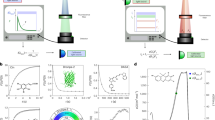Abstract
Theoretical relationships suitable for both constant-wavelength and variable-angle synchronous fluorescence in the wavelength domain were obtained for the calculation of peak location, intensity, and half-width of synchronous fluorescence spectra. The calculated values were compared with experimental data and the data derived from the literature equations, indicating that the proposed methods are feasible, less formidable, and more straightforward in the wavelength domain than previous ones. The proposed approaches provide a theoretical guide for the experimental design of synchronous fluorescence spectrometric methods in the wavelength domain. On the basis of the theoretical derivation, special characteristics of the peak half-bandwidths of the spectra were revealed. In certain cases, the bandwidth of a variable-angle synchronous spectrum is of less practical meaning.
Similar content being viewed by others
REFERENCES
S. A. Soper, L. B. McGown, and I. M. Warner (1994) Anal. Chem. 66, 428R–444R.
P. Canizares and M. D. Luque de Castro (1996) Fresenius J. Anal. Chem. 354, 291–295.
T. A. Taylor and H. H. Patterson (1987) Anal. Chem. 59, 2180–2187.
T. Vo-Dinh (1978) Anal. Chem. 50, 396–401.
T. P. Ruiz, C. Martinerz-Lozano, V. Tomas, and J. Carpena (1998) Talanta 45, 969–976.
A. Seritti, L. Nannicini, and R. D. Vecchio (1996) Environ. Tech. 17, 25–33.
J. A. M. Pulgarin, A. A. Molina, and P. F. Lopez (1997) Anal. Biochem. 245, 8–16.
W. C. Bell, K. S. Booksh, and M. L. Myrick (1998) Anal. Chem. 70, 332–339.
E. L. Inman and J. D. Winefordner (1982) Anal. Chem. 54, 2018–2022.
J. J. B. Nevado, J. A. M. Pulgarin, and M. A. G. Laguna (1995) Talanta 42, 129–136.
Y. Q. Li, X. Z. Huang, J. G. Xu, and G. Z. Chen (1992) Anal. Chim. Acta 256, 285–291.
J. A. M. Pularin and A. A. Molina (1996) Anal. Chim. Acta 319, 361–368.
A. S. Carretero, C. C. Blanco, and A. F. Gutierrez (1997) Anal. Chim. Acta 353, 337–344.
Y. Q. Li and L. Shi (1995) Chin. Chem. Lett. 6, 789–790.
Y. Q. Li, X. Z. Huang, J. G. Xu, and G. Z. Chen (1994) Talanta 41, 695–701.
Y. Q. Li and X. Z. Huang (1997) Fresenius J. Anal. Chem. 357, 1072–1075.
S. E. Cabaniss (1991) Anal. Chem. 63, 1323–1327.
E. L. Inman, L. A. Files, and J. D. Winefordner (1986) Anal. Chem. 58, 2156–2160.
J. B. F. Lloyd and I. W. Evett (1977) Anal. Chem. 49, 1710–1715.
Ph. Baudot and J. C. Andre (1982) Anal. Lett. 15, 471–492.
Y. Q. Li, X. Z. Huang, and J. G. Xu (1993) Fenxi Huaxue 21, 770–774.
J. G. Xu and R. T. Xu (1990) Chem. J. Chin. Univ. 11, 350–354.
Author information
Authors and Affiliations
Rights and permissions
About this article
Cite this article
Li, YQ., Huang, XZ. & Xu, JG. Synchronous Fluorescence Spectrometric Methodology in the Wavelength Domain. Journal of Fluorescence 9, 173–179 (1999). https://doi.org/10.1023/A:1022547315162
Issue Date:
DOI: https://doi.org/10.1023/A:1022547315162




